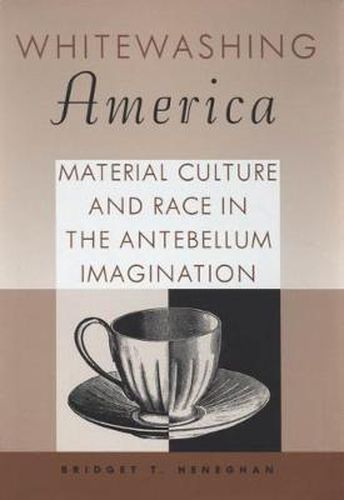Readings Newsletter
Become a Readings Member to make your shopping experience even easier.
Sign in or sign up for free!
You’re not far away from qualifying for FREE standard shipping within Australia
You’ve qualified for FREE standard shipping within Australia
The cart is loading…






This title is printed to order. This book may have been self-published. If so, we cannot guarantee the quality of the content. In the main most books will have gone through the editing process however some may not. We therefore suggest that you be aware of this before ordering this book. If in doubt check either the author or publisher’s details as we are unable to accept any returns unless they are faulty. Please contact us if you have any questions.
Even before mass marketing, American consumers bought products that gentrified their households and broadcast their sense of the good things in life.
Bridging literary scholarship, archaeology, history, and art history, Whitewashing America: Material Culture and Race in the Antebellum Imagination explores how material goods shaped antebellum notions of race, class, gender, and purity. From the Revolutionary War until the Civil War, American consumers increasingly sought white-colored goods. Whites preferred mass-produced and specialized products, avoiding the former dark, coarse, low-quality products issued to slaves. White consumers knit around themselves refined domestic items, visual reminders of who they were, equating wealth, discipline, and purity with the racially white.
Clothing, paint, dinnerware, gravestones, and buildings staked a visual contrast, a portable, visible title and deed segregating upper-class whites from their lower-class neighbors and household servants. This book explores what it meant to be white by delving into the whiteness of dishes, gravestone art, and architecture, as well as women’s clothing and corsets, cleanliness and dental care, and complexion. Early nineteenth-century authors participated in this material economy as well, building their literary landscapes in the same way their readers furnished their households and manipulating the understood meanings of things into political statements. Such writers as James Fenimore Cooper and John Pendleton Kennedy use setting descriptions to insist on segregation and hierarchy. Such authors as Harriet Beecher Stowe, Nathaniel Hawthorne, Edgar Allan Poe, and Herman Melville, struggled to negotiate messages of domesticity, body politics, and privilege according to complex agendas of their own. Challenging the popular notions, slave narrators such as Frederick Douglass and Harriet Jacobs wielded white objects to reverse the perspective of their white readers and, at times, to mock their white middle-class pretensions.
$9.00 standard shipping within Australia
FREE standard shipping within Australia for orders over $100.00
Express & International shipping calculated at checkout
This title is printed to order. This book may have been self-published. If so, we cannot guarantee the quality of the content. In the main most books will have gone through the editing process however some may not. We therefore suggest that you be aware of this before ordering this book. If in doubt check either the author or publisher’s details as we are unable to accept any returns unless they are faulty. Please contact us if you have any questions.
Even before mass marketing, American consumers bought products that gentrified their households and broadcast their sense of the good things in life.
Bridging literary scholarship, archaeology, history, and art history, Whitewashing America: Material Culture and Race in the Antebellum Imagination explores how material goods shaped antebellum notions of race, class, gender, and purity. From the Revolutionary War until the Civil War, American consumers increasingly sought white-colored goods. Whites preferred mass-produced and specialized products, avoiding the former dark, coarse, low-quality products issued to slaves. White consumers knit around themselves refined domestic items, visual reminders of who they were, equating wealth, discipline, and purity with the racially white.
Clothing, paint, dinnerware, gravestones, and buildings staked a visual contrast, a portable, visible title and deed segregating upper-class whites from their lower-class neighbors and household servants. This book explores what it meant to be white by delving into the whiteness of dishes, gravestone art, and architecture, as well as women’s clothing and corsets, cleanliness and dental care, and complexion. Early nineteenth-century authors participated in this material economy as well, building their literary landscapes in the same way their readers furnished their households and manipulating the understood meanings of things into political statements. Such writers as James Fenimore Cooper and John Pendleton Kennedy use setting descriptions to insist on segregation and hierarchy. Such authors as Harriet Beecher Stowe, Nathaniel Hawthorne, Edgar Allan Poe, and Herman Melville, struggled to negotiate messages of domesticity, body politics, and privilege according to complex agendas of their own. Challenging the popular notions, slave narrators such as Frederick Douglass and Harriet Jacobs wielded white objects to reverse the perspective of their white readers and, at times, to mock their white middle-class pretensions.